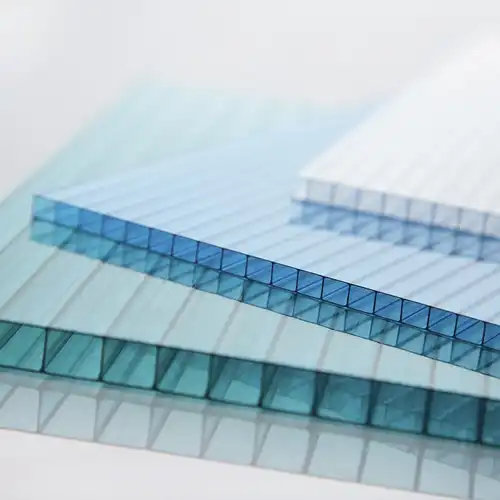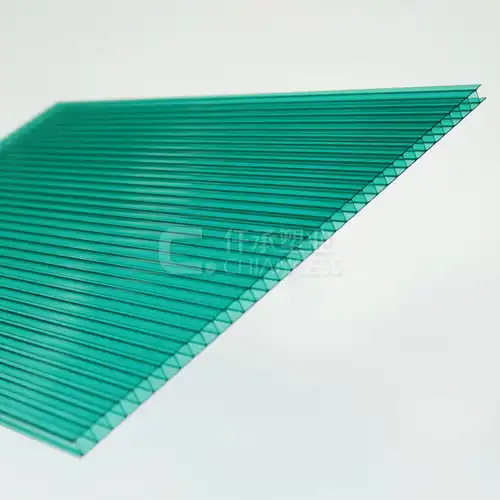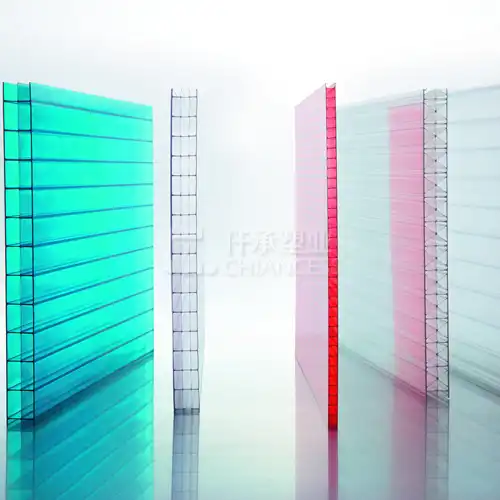July 17, 2024
Due to their distinctive properties and advantages, polycarbonate sheets have emerged as a popular material choice for a variety of applications. Polycarbonate sheets are used in construction, manufacturing, and even everyday products because they are known for their durability, versatility, and resistance to high impacts. In this blog, we'll talk about the benefits of polycarbonate sheets, why they're becoming more and more popular, and why you might want to use them for your next project.
What Are the Benefits of Polycarbonate Sheets?
Polycarbonate sheets are superior to other materials like acrylic and glass for a variety of reasons. You can make an informed choice based on your specific requirements if you are aware of these benefits. Due to their numerous advantages, polycarbonate sheets stand out from other materials like acrylic and glass. Due to their light weight, resistance to impact, and exceptional durability, they are suitable for a wide range of applications. Additionally, these sheets are highly resistant to UV rays, ensuring long-term clarity and performance. You will be able to make well-informed decisions that are tailored to the requirements of each project, whether they are related to construction, safety barriers, or environmental protection, once you are aware of these benefits.
Durability and Impact Resistance
Sheets made of polycarbonate are extremely durable and able to withstand the elements. They are frequently used in construction for skylights, facades, and roofs.
Sheets made of polycarbonate are also durable and able to withstand a lot of pressure. Polycarbonate can withstand a lot of hits without breaking, in contrast to glass, which breaks easily. As a result, it is an excellent material for bulletproof windows, safety goggles, and protective barriers.
Light Transmission and UV Protection
Like glass, polycarbonate sheets let light in. Windows, skylights, and greenhouses can all be constructed on this property. Some sheets of polycarbonate are capable of transmitting up to 90% of light, making them nearly as transparent as glass but safer and more long-lasting.
UV rays are also shielded from by this product. A coating that is resistant to UV rays blocks harmful UV rays on many polycarbonate sheets. This is crucial for things like automobiles and outdoor structures that could be damaged by sunlight. The sheets remain clear and last a long time thanks to the UV protection.
Flexibility and Ease of Installation
The flexibility of it is yet another compelling advantage. Polycarbonate, in contrast to glass, which is rigid and susceptible to breaking under pressure, is simple to bend and shape to fit a variety of designs and structures. Designers can achieve unique shapes and forms that would be difficult or impossible with other materials thanks to this flexibility, which makes it possible for more creative and innovative architectural solutions.
They are easier to install and handle than glass because they are lighter. Whether you're working on a small DIY project or a large construction site, their light weight makes installation easier and reduces transportation costs. Polycarbonate's ease of use is further enhanced by the fact that it can be cut and drilled with standard tools.
How Do Polycarbonate Sheets Compare to Glass and Acrylic?
When choosing between polycarbonate sheets, glass, and acrylic, it's essential to understand the differences and advantages each material offers. Polycarbonate sheets often stand out due to their unique properties.
Strength and Safety
They are more durable than acrylic and glass sheets. Polycarbonate is practically indestructible, whereas acrylic resists impact more effectively than glass. Due to its superior strength, polycarbonate is the material of choice for bulletproof windows and barrier protection when acrylic or glass would not suffice.
Polycarbonate offers additional safety advantages in addition to its resistance to impacts. Polycarbonate does not break into dangerous, sharp shards like glass does when it does. Instead, it usually cracks in a way that is safer and less dangerous. This quality is especially important in places like schools, hospitals, and public buildings where people's safety is a concern.
Weather Resistance and Longevity
Glass is susceptible to cracking or breaking in severe weather, such as hailstorms or heavy snowfall, despite its ability to withstand a variety of conditions. Even though acrylic is stronger than glass, it can become brittle if it is exposed to the elements for too long. Polycarbonate, on the other hand, is designed to withstand severe weather without deteriorating. Because it can withstand changes in temperature, UV rays, and physical impacts, it is a material that is long-lasting and durable for use in outdoor applications.
In comparison to acrylic, which can yellow and degrade when exposed to UV light for an extended period of time, they also maintain their clarity and appearance better over time. Many polycarbonate sheets have UV coatings that keep them clear and aesthetically pleasing for a long time by protecting them from the sun.
Cost and Efficiency
While polycarbonate sheets can be more expensive initially compared to glass and acrylic, their long-term benefits often justify the higher cost. The durability and low maintenance requirements of polycarbonate mean that it does not need to be replaced as frequently as glass or acrylic, leading to cost savings over time.
Additionally, the ease of installation and the flexibility of it can result in labor cost savings. The lightweight nature of polycarbonate reduces transportation and handling costs, making it a cost-effective choice for many projects.
Why Are Polycarbonate Sheets Used in Greenhouses?
Polycarbonate sheets have become a popular choice for greenhouse construction due to their unique properties that benefit plant growth and greenhouse maintenance.
Optimal Light Transmission
For a greenhouse, light transmission is crucial, and they excel in this area. They allow a significant amount of natural light to pass through, which is essential for photosynthesis and healthy plant growth. Some of them can transmit up to 90% of sunlight, similar to glass, but with added benefits that glass cannot provide.
Thermal Insulation
They offer excellent thermal insulation, which is vital for maintaining consistent temperatures within a greenhouse. Unlike glass, which can allow heat to escape easily, polycarbonate helps to retain heat, reducing the need for additional heating during colder months. This insulation property not only creates a more stable growing environment for plants but also contributes to energy savings, making greenhouses more efficient and cost-effective to operate.
UV Protection
Another critical factor for greenhouses is UV protection. While plants need sunlight, excessive UV exposure can be harmful. The products with UV-resistant coatings filter out harmful UV rays while allowing the beneficial light spectrum to pass through. This feature protects plants from potential UV damage and ensures that the light entering the greenhouse is optimal for growth.
Durability and Maintenance
They are ideal for greenhouses because they can withstand a variety of weather conditions. They can withstand hail, strong winds, and other weather-related challenges without breaking because of their impact resistance. Polycarbonate is a low-maintenance option for greenhouse owners because of its durability, which cuts down on the need for frequent repairs or replacements.
They are also resistant to a wide range of chemicals and environmental factors that can degrade other materials. They are a great investment for greenhouse construction because of their resistance, which increases their longevity even further.
Design Flexibility
Polycarbonate sheets allow for imaginative and practical greenhouse structures because they offer design flexibility. They can be used in a variety of greenhouse designs, including more contemporary curved designs and traditional A-frame structures, thanks to their ease of cutting, shaping, and bending. Because of their adaptability, greenhouse builders are able to create environments that are tailored to the requirements of particular plants and their aesthetic preferences.
Conclusion
They provide numerous benefits across various applications, from construction to greenhouses. Their durability, light transmission, UV protection, and ease of installation make them a superior choice compared to traditional materials like glass and acrylic. Whether you are considering polycarbonate for its safety features, weather resistance, or cost efficiency, it is a material that offers both performance and versatility.
If you are interested in our products, you can contact us at: simon@chiancess.com.
References
- Home Depot. (n.d.). Polycarbonate Sheets. Retrieved from https://www.homedepot.com
- Polycarbonate Roofing. (n.d.). The Benefits of Polycarbonate Sheets. Retrieved from https://www.polycarbonateroofing.com
- Tuflite. (n.d.). Why Choose Polycarbonate Sheets? Retrieved from https://www.tuflite.com
- Palram Americas. (n.d.). Polycarbonate vs. Glass vs. Acrylic. Retrieved from https://www.palram.com
- A&C Plastics. (n.d.). Comparing Polycarbonate and Acrylic. Retrieved from https://www.acplasticsinc.com
- Greenhouse Megastore. (n.d.). Polycarbonate Greenhouse Covering. Retrieved from https://www.greenhousemegastore.com
- Regal Plastics. (n.d.). Advantages of Polycarbonate Sheets. Retrieved from https://www.regal-plastics.com
- Plastic Sheets Shop. (n.d.). What are the benefits of Polycarbonate? Retrieved from https://www.plasticsheetsshop.co.uk
- Curbell Plastics. (n.d.). Polycarbonate Properties. Retrieved from https://www.curbellplastics.com
- Simply Plastics. (n.d.). The Benefits of Using Polycarbonate. Retrieved from https://www.simplyplastics.com
.webp)




















